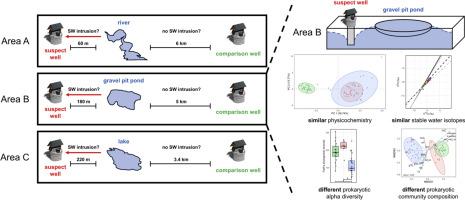当前位置:
X-MOL 学术
›
Water Res.
›
论文详情
Our official English website, www.x-mol.net, welcomes your
feedback! (Note: you will need to create a separate account there.)
Physicochemical and isotopic similarity between well water and intruding surface water is not synonymous with similarity in prokaryotic diversity and community composition
Water Research ( IF 11.4 ) Pub Date : 2024-11-18 , DOI: 10.1016/j.watres.2024.122812 Kevin J. Lyons, Vadim Yapiyev, Kaisa Lehosmaa, Anna-Kaisa Ronkanen, Pekka M. Rossi, Katharina Kujala
Water Research ( IF 11.4 ) Pub Date : 2024-11-18 , DOI: 10.1016/j.watres.2024.122812 Kevin J. Lyons, Vadim Yapiyev, Kaisa Lehosmaa, Anna-Kaisa Ronkanen, Pekka M. Rossi, Katharina Kujala

|
Intruding surface water can impact the physicochemical and microbiological quality of groundwater. Understanding these impacts is important because groundwater provides much of the world's potable water, and reduced quality is a potential public health risk. In this study, we monitored six shallow groundwater wells and three surface water bodies in the North Ostrobothnia region of Finland twice monthly for 12 months (October 2021–October 2022) via (i) on-site and off-site measurements of physicochemical water quality parameters, (ii) determination of stable water isotope compositions, and (iii) analysis of microbial communities (via amplicon sequencing of the V3–V4 16S rRNA gene sub-regions). Water from one well showed clear overall physicochemical and isotopic similarity with a nearby pond, as well as temporal fluctuations in water temperature and isotopes that mirrored those of the pond. Isotope mixing analyses suggested that about 80–95% of the well water comes from the pond. Such large-scale intrusion might be expected to reduce prokaryotic diversity and composition in the aquifer, either by strong influx of surface water taxa or changes to aquifer physicochemistry. Compared to the pond, however, prokaryotic communities from the well showed significantly higher alpha diversity and a composition more similar to a nearby well unaffected by intrusion. The finding that physicochemical and isotopic similarity between well water and intruding surface water is not synonymous with similarity in prokaryotic diversity and community composition makes clear the need for a multi-method approach when studying the impact of surface water intrusion on shallow wells.
中文翻译:

井水和侵入地表水之间的物理化学和同位素相似性并不等同于原核生物多样性和群落组成的相似性
侵入的地表水会影响地下水的物理化学和微生物质量。了解这些影响非常重要,因为地下水提供了世界上大部分的饮用水,而地下水质量下降是一个潜在的公共卫生风险。在这项研究中,我们通过 (i) 物理化学水质参数的现场和非现场测量,(ii) 稳定水同位素组成的测定,以及 (iii) 微生物群落分析(通过 V3-V4 16S rRNA 基因亚区域的扩增子测序),每月两次监测芬兰北博滕地区的 6 口浅层地下水井和 3 个地表水体,持续 12 个月(2021 年 10 月至 2022 年 10 月)。一口井的水与附近的池塘显示出明显的整体物理化学和同位素相似性,以及水温和同位素的时间波动,与池塘的同位素相似。同位素混合分析表明,大约 80-95% 的井水来自池塘。这种大规模的入侵可能会减少含水层中的原核多样性和组成,要么是地表水类群的大量涌入,要么是含水层物理化学的变化。然而,与池塘相比,该井的原核生物群落显示出明显更高的 α 多样性,并且其组成更类似于附近未受侵入影响的井。井水和侵入地表水之间的物理化学和同位素相似性并不等同于原核生物多样性和群落组成的相似性,这一发现清楚地表明,在研究地表水侵入对浅井的影响时需要采用多方法方法。
更新日期:2024-11-18
中文翻译:

井水和侵入地表水之间的物理化学和同位素相似性并不等同于原核生物多样性和群落组成的相似性
侵入的地表水会影响地下水的物理化学和微生物质量。了解这些影响非常重要,因为地下水提供了世界上大部分的饮用水,而地下水质量下降是一个潜在的公共卫生风险。在这项研究中,我们通过 (i) 物理化学水质参数的现场和非现场测量,(ii) 稳定水同位素组成的测定,以及 (iii) 微生物群落分析(通过 V3-V4 16S rRNA 基因亚区域的扩增子测序),每月两次监测芬兰北博滕地区的 6 口浅层地下水井和 3 个地表水体,持续 12 个月(2021 年 10 月至 2022 年 10 月)。一口井的水与附近的池塘显示出明显的整体物理化学和同位素相似性,以及水温和同位素的时间波动,与池塘的同位素相似。同位素混合分析表明,大约 80-95% 的井水来自池塘。这种大规模的入侵可能会减少含水层中的原核多样性和组成,要么是地表水类群的大量涌入,要么是含水层物理化学的变化。然而,与池塘相比,该井的原核生物群落显示出明显更高的 α 多样性,并且其组成更类似于附近未受侵入影响的井。井水和侵入地表水之间的物理化学和同位素相似性并不等同于原核生物多样性和群落组成的相似性,这一发现清楚地表明,在研究地表水侵入对浅井的影响时需要采用多方法方法。


















































 京公网安备 11010802027423号
京公网安备 11010802027423号